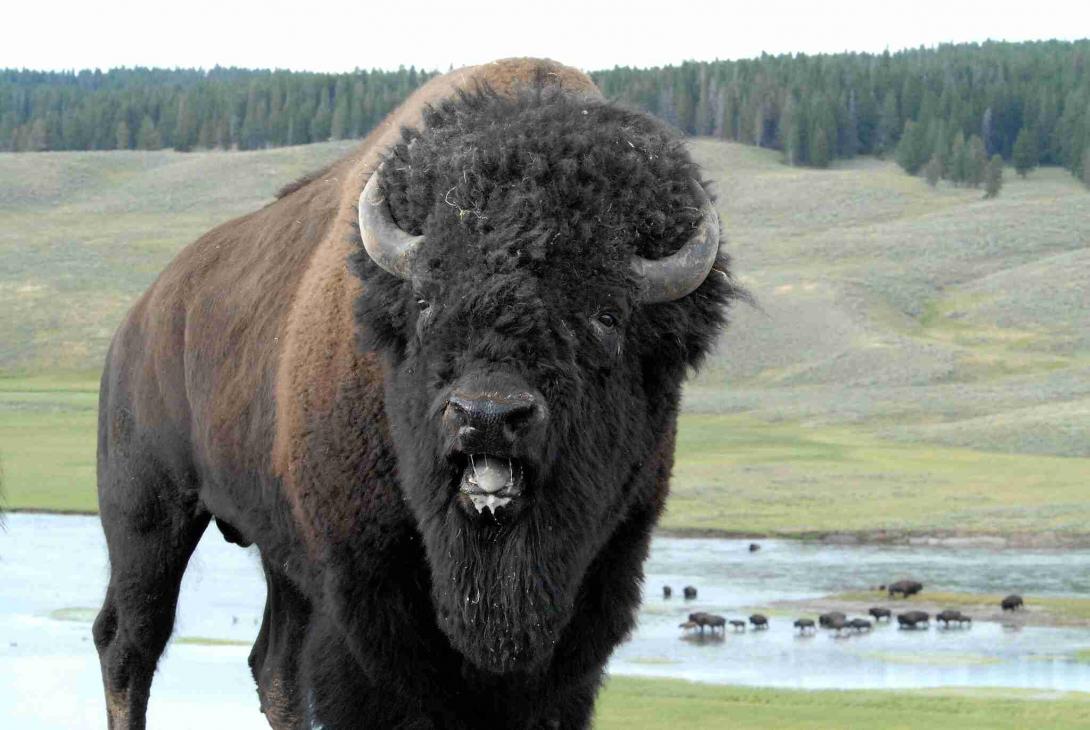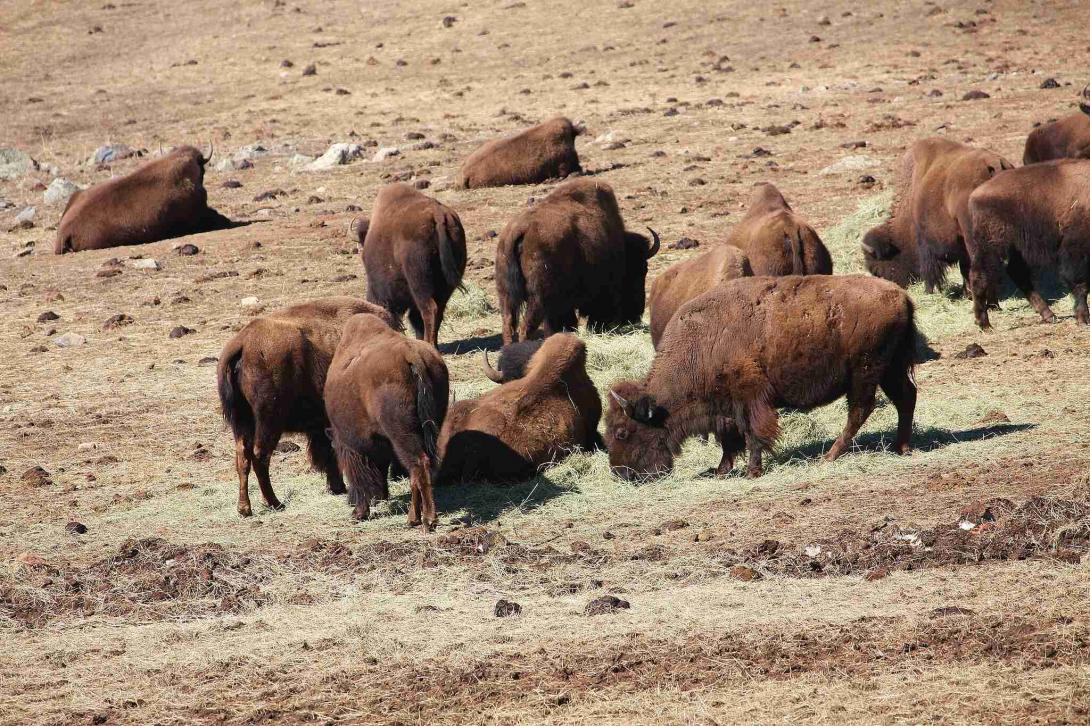Bison
Full Article
The American Plains Bison (Bison bison) are large mammals in the Bovidae family, recognizable for their large head, shaggy coats, pronounced hump, and close association with the American West. Bison are commonly and incorrectly referred to as "buffalo," which are Asian and African animals. North American bison have long grazed in Colorado and are a central part of the spiritual and physical world of Colorado’s Indigenous people.
For millennia, vast herds of bison roamed the Great Plains, until their numbers declined almost to extinction in the nineteenth century due to overhunting. Since then, however, their significance in American culture and their importance as a keystone species for the natural environment of the plains have prompted conservation efforts and a modest population resurgence. Today, those efforts have resulted in several managed bison herds across Colorado. In 2016 President Barack Obama named the bison the National Mammal of the United States.
Biology
Bison are diurnal animals, meaning they are active during the day. Historically, bison had distinct seasonal behaviors. In the winter, the gregarious mammals moved in small groups to seek forage and shelter, and in the summer months, they consolidated into massive herds for breeding and to protect the young. A much smaller population of free-ranging bison today continues these seasonal movements.
Female bison, called cows, reach sexual maturity at about two to four years and typically give birth to only one calf at a time. The bison’s relatively slow reproduction rate compounded their decline when they were overhunted during the late nineteenth century. Calves are weaned off their mother’s milk after about one year. Male bison, called bulls, reach peak mass at about five to six years of age. Most bison do not live past twenty years.
Bison-Shortgrass Relationship
The Great Plains is the largest biome in North America. The High Plains, a part of that biome that extends across northeast Colorado to the foot of the Rocky Mountains, is an ideal environment for bison, the area’s keystone species. Bison have shaped the area to fit their needs. The shortgrass ecology of the High Plains consists of two primary types of grass, blue grama (Bouteloua gracilis) and buffalo grass (Buchloë dactyloides), both of which have shallow root systems and grow unimpeded by the aridity that characterizes the region. Bison themselves are selected for these dominant varieties based on the nutrition they provide and their tolerance to cyclical patterns of wet and dry years. The shortgrass provides bison with a crucial nutritional balance of protein and carbohydrates; as much as 90 percent of a bison’s diet consists of grasses and sedges.
Further, the grazing of bison herds induces new growth for both blue grama and buffalo grass, while their droppings return critical fertilizer to the prairie soil. Their grazing patterns are more intentional than one would think, with herds returning to graze the same carefully selected areas. This symbiotic relationship is why bison have existed for many millennia on the High Plains and have long been a central resource for the people living there.
Bison and Indigenous Nations
Archaeological evidence from across Colorado confirms that bison were a staple food resource for people living in the region as far back as the Paleo-Indian period (more than 9,000 years ago). At the Jones-Miller and Olsen-Chubbuck Bison Kill Sites, which date to about 8,000 BCE, Paleo-Indians herded bison into gulches, killed them, and butchered the bodies. At these and other sites, pot sherds, projectile points, and bone debris indicate that the people who populated the High Plains hunted bison in cooperative groups and used their quarry for food, clothing, tools, and other materials. At the Massey Draw site near Denver, the large number of bones and the existence of modified organic materials for use as tools suggest that the site was a bison-processing encampment in the Middle Archaic Period (~3,000-1,000 BCE). Similar killing and butchering techniques continued on the plains for thousands of years.
In addition to its functional role as a food source, the bison is spiritually vital to many Western Great Plains Indigenous people. The nations most commonly associated with Colorado—including the Arapaho, Cheyenne, and Nuche (Ute) people—all depended on the bison as a food source. They held, and still hold, the animals as an essential part of their physical and spiritual connection to the land. To the Arapaho, who call the bison heneecee, the animal provided food and shelter and was a key component of trade and commerce. The Cheyenne, who call the bison hotoa’e and hunted them in extended family units, traded meat and pemmican to the horticultural nations on the eastern Great Plains in exchange for corn and wild foods. In addition, the Nuche, who call the bison coch or kucu, left their mountain encampments each summer to hunt bison herds on the Great Plains. They hunted bison for their own needs as well as to establish trade with Spanish colonists, known as Ciboleros, who specialized in the trade of bison flesh at markets in New Mexico.
Bison were the foundation of transactions among Indigenous groups and between Indigenous nations and Euro-American nations. In this way, the mammals’ abundance undergirded the more extensive networks of imperial commerce on the nineteenth-century plains, such as the Santa Fé Trail. Bison meat, hides, and tallow (fat) were principal commodities on the Great Plains. The market forces that came to bear on the region eventually spelled disaster for the bison in Colorado.
The Market for Bison
A variety of market factors drove the exploitation of the bison, including flesh for consumption or storage and bone ash for making fertilizer or to neutralize acids and clarify sugar, wine, and vinegar. However, in the early decades of the nineteenth century, demand for bison pelts surpassed these other uses as the main driver of the animal’s decline. Stemming directly from the already-established beaver pelt trade, the bison robe market became dominant as beaver became rarer in the mountains and High Plains.
The earliest American engagement with the bison robe market occurred in the early nineteenth century at trading posts along overland trails. Bent’s Fort, on the Arkansas River in what is now Otero County, was a well-known fur-trading post and commercial hub. There, white traders exchanged flour, firearms, textiles, and liquor for bison robes prepared by the Cheyenne, Arapaho, and other Indigenous peoples. In tandem with intensifying resource competition between bison and the growing herds of horses used to hunt them, the massive demand for robes contributed to a decline in bison, as Indigenous people were incentivized to overhunt the animal. By the 1850s, the decline in the robe market shuttered many of the fur-trading forts in Colorado, and Indigenous people who relied upon the once-innumerable resource began to starve and relocate as herds diminished.
Several forces combined to keep bison numbers on a downward trajectory throughout the mid-nineteenth century. Increasing numbers of American colonists crossing the plains on overland trails used bison as a food source. The Comanche overhunted bison to sustain their raiding-and-trading empire and built huge horse herds that competed with the bison for grazing territory.
As railroad tracks were laid across eastern Colorado during the 1870s, bison migration patterns were affected, and train strikes began killing bison who wandered across tracks. An increasing number of cattle and other ranch animals and the increasing amount of acreage put under cultivation reduced bison’s access to vital shortgrass prairie, and irrigation ditches bisected their grazing spaces. Droughts, wildfires, blizzards, and disease contributed significantly to the diminishing number of bison in Colorado and the broader Great Plains, as did the forced removal of Indigenous people who had previously managed the herds and held bison in higher regard than newly arriving colonists. On top of all that, tanners developed a new method for creating bison leather in the early 1870s, creating an insatiable demand for hides. By the 1880s, bison had been nearly hunted out of existence on the High Plains.
Saving a Species: Bison in the Twentieth Century
At the turn of the twentieth century, the bison underwent a transformation in the minds of many non-Indigenous Americans. For decades, hunting of the animals had been encouraged to weaken Indigenous nations and make way for the so-called progress of railroads, farming, and ranching in the West. With the conquest of the region complete, however, many Americans began to see both the bison and Indigenous people as symbols of a disappearing mythical frontier, and they became nostalgic about these symbols.
Perhaps the best example of this change in sentiment is that of William F. “Buffalo Bill” Cody, an army veteran who hunted bison for the Kansas-Pacific Railroad and the US Army only to make the animals an important part of his subsequent “Wild West” shows that celebrated the American frontier. Cody’s shows were immensely popular and gave bison staying power as symbols of a romanticized American West. Cody, who first helped kill the bison and then helped spur a national lamentation of their loss, is now buried on Lookout Mountain, near Golden, not far from where a reintroduced bison herd roams.
Later, in 1934, the University of Colorado (CU) adopted the name “Buffaloes” to represent its sports programs and campus community, further tying the bison to the lives of contemporary Coloradans. The mascot was chosen due to a national naming contest by CU’s student newspaper, Silver & Gold. Boulder resident A. J. Dickson was the first to submit the name “buffaloes.” For the first football game of the 1934 season, CU students paid twenty-five dollars to have a bison calf on the sidelines (it is not known where the calf was taken from, though it likely came from Genesee Park). Since 1967 CU has had a live female bison, nicknamed “Ralphie,” lead the football team onto the field at home games.
In Colorado, conservation of the keystone species has been in progress since the early twentieth century. Beginning in 1908, the city of Denver rounded up a herd of eighteen bison for conservation. The Denver herd lived on the prairie of City Park and the Denver Zoo, but as the herd grew, its home moved to a larger site at Genesee Park in 1914 and expanded to Daniels Park in 1938. The city of Denver and the Denver Zoo continue to manage the bison herd, occasionally gifting bison to the Cheyenne, Arapaho, Ute, and other Indigenous nations with strong cultural ties to the animals. Collectively, these efforts protect the region’s biodiversity, support the recovery of the species, acknowledge Indigenous nations as equal partners in their protection, and provide the people of Colorado the opportunity to engage with one of their region’s most important species.
Today
Bison reintroduction programs continue in Colorado, and the state herds have increased significantly in number and physical health. A short distance from Denver, Coloradans can view the bison herd at Rocky Mountain Arsenal. In Golden, the overlook at exit 254 off Interstate 70 allows observation of the Genesee Park herd. In Larimer County, bison viewing areas at Soapstone Prairie Natural Area and Red Mountain Open Space enable visitors to see a herd with genetic links to some of the last remaining wild bison in the Yellowstone region. The state of Colorado, the federal government, and many Indigenous nations continue to prioritize the reintroduction, study, and management of the prairie’s keystone species and the country’s national mammal.
















































































